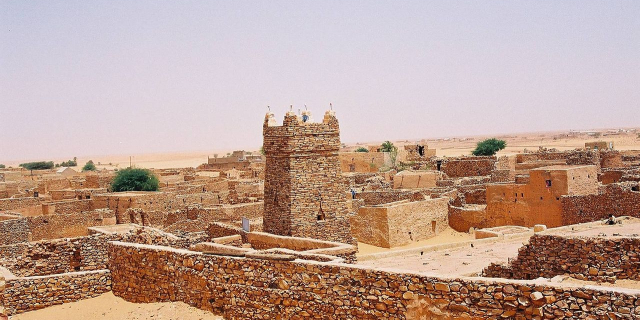Banc d'Arguin National Park
The Banc d'Arguin National Park (Arabic: حوض أركين, romanized: Ḥawḍ ʾArkīn, French: Parc national du Banc d'Arguin) of Bay of Arguin lies in Western Africa on the west coast of Mauritania between Nouakchott and Nouadhibou and is the former mouth of the Tamanrasset River. The World Heritage Site is a major site for migratory birds and breeding birds, including flamingos, pelicans and terns. Much of the breeding is on sand banks including the islands of Tidra, Niroumi, Nair, Kijji and Arguim. The surrounding waters are some of the richest fishing waters in western Africa and serve as nesting grounds for the entire western region.
The Banc d'Arguin National Park is a Nature reserve that was established in 1976 to protect both the natural resources and the valuable fisheries, which makes a significant contr...Read more
The Banc d'Arguin National Park (Arabic: حوض أركين, romanized: Ḥawḍ ʾArkīn, French: Parc national du Banc d'Arguin) of Bay of Arguin lies in Western Africa on the west coast of Mauritania between Nouakchott and Nouadhibou and is the former mouth of the Tamanrasset River. The World Heritage Site is a major site for migratory birds and breeding birds, including flamingos, pelicans and terns. Much of the breeding is on sand banks including the islands of Tidra, Niroumi, Nair, Kijji and Arguim. The surrounding waters are some of the richest fishing waters in western Africa and serve as nesting grounds for the entire western region.
The Banc d'Arguin National Park is a Nature reserve that was established in 1976 to protect both the natural resources and the valuable fisheries, which makes a significant contribution to the national economy, as well as scientifically and aesthetically valuable geological sites, in the interests of and for the recreation of the general public.
The park's vast expanses of mudflats provide a home for over one million migrant shorebirds from northern Europe, Siberia and Greenland. The region's mild climate and absence of human disturbance makes the park one of the most important sites in the world for these species. The nesting bird population is also noted for its great numbers and diversity. Between 25,000 and 40,000 pairs belonging to 15 species, making the largest colonies of water birds in West Africa.
 Shell midden several kilometers long and tens of meters high proving an intense prehistoric use of the area
Shell midden several kilometers long and tens of meters high proving an intense prehistoric use of the areaBecause of its rich fishery and strategic location, the territory has been highly coveted and disputed by the European colonial powers of Portugal, France, England, Brandenberg/Prussia and Holland.
1445 – 5 February 1633 Portuguese rule (Arguim). 5 February 1633 – 1678 Dutch rule (brief English occupation in 1665). 1 September 1678 – September 1678 French occupation. September 1678 Abandoned. 5 October 1685 – 7 March 1721 Brandenburg (from 1701, Prussian) rule. 7 March 1721 – 11 January 1722 French rule. 11 January 1722 – 20 February 1724 Dutch rule. 20 February 1724 – March 1728 French rule. The Wreck of Medusa – La Méduse was a French frigate that ran aground at high tide off Banc d'Arguin on 2 July 1816.A scene inspired by the account of survivors Alexandre Corréard and Jean-Baptiste-Henri Savigny was made the subject of a painting in 1819 by Théodore Géricault called "The Raft of the Medusa", which is displayed in the Louvre Museum in Paris, France.
 The Raft of the Medusa, Théodore Géricault
The Raft of the Medusa, Théodore GéricaultDespite the Almoravid domination of Spain in the eleventh and twelfth centuries, there seems to be little evidence of contact during that time between Mauritania and Europe. The inhospitable coastline of Mauritania continued to deter voyagers until the Portuguese began their African explorations in the fifteenth century. Lured by legends of vast wealth in interior kingdoms, the Portuguese established a trading fort at Arguin, southeast of Cap Blanc (present-day Ras Nouadhibou), in 1455. The king of Portugal also maintained a commercial agent at Ouadane in the Adrar in an attempt to divert gold traveling north by caravan. Having only slight success in their quest for gold, the Portuguese quickly adapted to dealing in slaves. In the mid-fifteenth century, as many as 1,000 slaves per year were exported from Arguin to Europe and to the Portuguese sugar plantations on the island of São Tomé in the Gulf of Guinea.
With the merger of the Portuguese and Spanish crowns in 1580, the Spaniards became the dominant influence along the coast. In 1638, however, they were replaced by the Dutch, who were the first to begin exploiting the gum arabic trade. Produced by the acacia trees of Trarza and Brakna and used in textile pattern printing, this gum arabic was considered superior to that previously obtained in Arabia. By 1678 the French had driven out the Dutch and established a permanent settlement at Saint Louis at the mouth of the Senegal River, where the French Company of the Senegal River (Compagnie Française du Sénégal) had been trading for more than fifty years.
The Moors, with whom the Europeans were trading, considered the constant rivalries between European powers a sign of weakness, and they quickly learned the benefits of playing one power against the other. For example, they agreed simultaneously to give monopolies to the French and the Dutch. The Maures also took advantage of the Europeans whenever possible, so that when the French negotiated with the amir of Trarza to secure a monopoly on the gum Arabic trade, the amir in exchange demanded a considerable number of gifts. Thus began the custom, an annual payment expected by the Maures for doing business with a government or a company. By 1763 the British had expelled France from the West African coast, and France recovered control only when the Congress of Vienna in 1815 recognized French sovereignty over the coast of West Africa from Cap Blanc south to Senegal.




























Add new comment